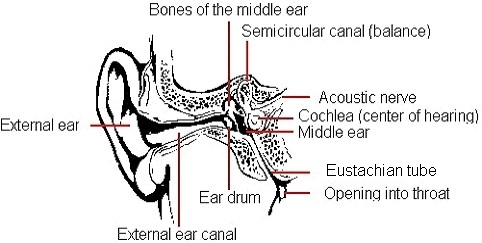What is it?
Acute otitis media (OM) is a middle ear infection that may cause a change in the normal eardrum, which is located at the inner end of the ear canal. In OM, the infection can be caused by a virus or by bacteria. It may also be associated with allergies, enlarged adenoids, or a cold that could result in the blockage of the eustachian tube (the connection between the throat and middle ear that equalizes pressure).
 In OM, there may be earache, fever, hearing loss, or a sense of fullness in the ear. In some cases there may be loss of appetite, vomiting, tinnitus (ringing in the ears), ear drainage, or a dizzy feeling (vertigo). Generally, OM is not contagious, although illnesses associated with ear infection, such as a cold, may be contagious. The time needed for the infection to clear up varies. Usually people begin to feel better several days after they start to take medication, but in the case of OM, some of the symptoms, such as a feeling of fullness or pressure in the ear, may last for several weeks. Length of treatment for OM varies.
In OM, there may be earache, fever, hearing loss, or a sense of fullness in the ear. In some cases there may be loss of appetite, vomiting, tinnitus (ringing in the ears), ear drainage, or a dizzy feeling (vertigo). Generally, OM is not contagious, although illnesses associated with ear infection, such as a cold, may be contagious. The time needed for the infection to clear up varies. Usually people begin to feel better several days after they start to take medication, but in the case of OM, some of the symptoms, such as a feeling of fullness or pressure in the ear, may last for several weeks. Length of treatment for OM varies.
Otitis externa
Otitis externa (OE) is an inflammation, irritation, or infection of the outer ear and ear canal, and is commonly called “swimmers ear.”
What causes it?
In OE, the infection is caused by bacteria or fungi. Scratching, inserting objects into the ear canal, or moisture (from swimming, for example), can make the ear canal vulnerable to infection.
What are its common symptoms?
In OE, the ear canal is red and swollen. It may be painful touch the ear and there may be yellow, yellow-green, pus-like, or foul smelling drainage from the external ear canal. There may also be fullness in the ear or loss of hearing.
Is it contagious?
In OE, the cause is not generally contagious.
How long will it last?
OE should be treated for 5-7 days.
How is it treated?
Treatment for this problem consists of two important parts: (1) what your health care provider can do, and (2) what you can do.
What can your health care provider do?
OM:
- Antibiotics – These medicines help to fight the infection. It is most important that you take all the medication provided, even if you are feeling better in two or three days. Depending upon your diagnosis, you may be prescribed an oral antibiotic or antibiotic ear drops.
- Decongestants and/or antihistamines – These medicines may help relieve the swelling of the eustachian tube and allow fluid to drain from the middle ear.
- Other medications – Your health care provider may prescribe medications, such as a pain reliever, to help with symptoms of the ear infection.
OE:
- Effective medications include ear drops containing antibiotics to fight infection, and corticosteroids to reduce swelling of the ear canal. If the ear canal is very swollen, a wick may be inserted into the ear canal to allow drops to travel to the end of the canal.
What can you do?
- Rest is important in helping the body cope with the infection process.
- Extra fluids, preferably water up to 6-8 glasses each day to prevent dehydration, are helpful if a fever is present.
- If pain is present, take acetaminophen or ibuprofen as directed on the package.
- For OE, keep the affected ear/s dry until topical therapy is completed. No swimming. To shampoo/shower, place cotton wisps gently in the ear canal to absorb water, and remove after shampooing/showering.
- Warm compresses to the ear may ease pain in OM. Use a washcloth wrung out in warm water for 15-20 minutes several times per day.
Can you prevent it?
It is very difficult to prevent a disease that is caused by a virus or bacteria. However, there are some things you can do to help.
- DO NOT USE INSTRUMENTS OR COTTON-TIPPED APPLICATORS TO CLEAN EARS! These tend to push ear wax back into the canal, thus causing wax buildup, or can injure the eardrum. The wax blocks the ear canal and makes it difficult to see the drum. This wax can also be the cause of decreased hearing. These items can also abrade or scratch the ear canal. The natural way to remove earwax is to let the tiny hairs in the ear propel the wax outward as the canal moves with talking or chewing. Let nature follow its course, or contact your health care provider.
- Avoid contact with allergy-causing agents if you are susceptible. Allergies can cause swelling of the eustachian tubes that result in blockage, and change in the air pressure behind the eardrum.
- At the first sign of a cold, treat the symptoms. Ask your health care provider for advice about managing colds and sore throats.
- If you swim often, or are prone to swimmer’s ear, ask your provider about use of preventive eardrops.
Common myths
- Going without a hat in cold weather causes ear infections – No, ear infections are not caused by going without your ears covered, or by cold/rainy weather. The middle ear most often becomes infected from bacteria that travel up the eustachian tube from the throat. However, exposure to cold/wind may make your ear pain worse when you have an ear infection.
- Ear infections run in families – No, there is no evidence that ear infections are inherited. Ear infections are most common in infants and young children because they have a shorter, less angled eustachian tube and because they have immature immune systems. People who have had frequent ear infections as a child may or may not continue to get them as adults.
Follow-up
It is important to return for your follow-up visit if your health care provider recommends that your ears be re-examined.
Remember
Notify your health care provider if you have any of the following:
- Blood or pus draining from the ear
- Continued fever
- Dizziness/vertigo
- Stiff neck
- Ringing of ears
- Pain or swelling behind or around the ear
- Persistent ear pain, especially if not relieved in 48 hours
Reference
- Cecil’s Textbook of Medicine, 23rd Ed. 2008.
- MedlinePlus web site, www.nlm.nih.gov/medlineplus, search for ear infection








